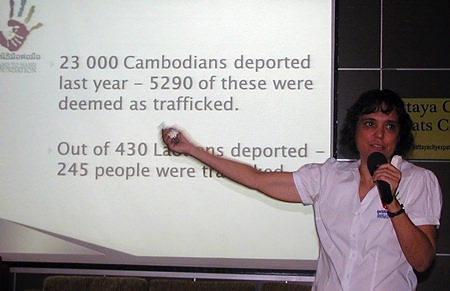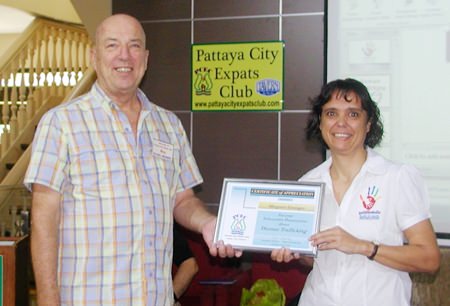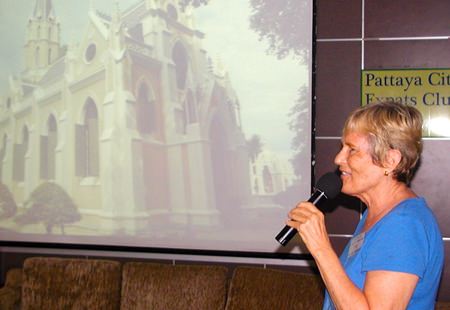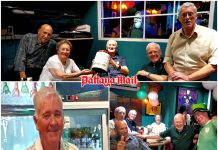Human trafficking is a modern form of slavery. This is how Margaret (Margie) Grainger, of the Hand To Hand Foundation, began her talk to the Pattaya City Expats Club at their Sunday meeting on October 13. More information on the foundation is available at www.handtohandpattaya. com. Margie began by saying that human trafficking is both an international and domestic problem; it also exists here in Pattaya.
Margie provided the following as an official definition of human trafficking, which she acknowledged was a mouthful: “All acts involved in the recruitment, abduction, transport, harboring, transfer, sale or receipt of persons, within national or across international borders, through force, coercion, fraud or deception, to place persons in situations of slavery or slavery-like conditions, forced labor or services, such as forced prostitution or sexual services, domestic servitude, bonded sweatshop labor, or other debt bondage.”
 Margaret (Margie) Grainger, of the Hand To Hand Foundation, began her talk to the Pattaya City Expats Club at their Sunday meeting on October 13, with the message “Human trafficking is a modern form of slavery”. Child beggars are one of the more obvious forms of human trafficking, but they are only the tip of the iceberg.
Margaret (Margie) Grainger, of the Hand To Hand Foundation, began her talk to the Pattaya City Expats Club at their Sunday meeting on October 13, with the message “Human trafficking is a modern form of slavery”. Child beggars are one of the more obvious forms of human trafficking, but they are only the tip of the iceberg.
She said sometimes it is easier to define what human trafficking is not rather than what it is. The movement of migrants between countries; people seeking refuge; people deciding to be smuggled into another country in search of a better life – these situations are not human trafficking. To be human trafficking, Margie said, there has to be both abduction and movement.
 Board member Roy Albiston presents Margie with a Certificate of Appreciation for her thought provoking presentation. More information about the ‘Hand To Hand’ organisation and its work can be found at http://www.handtohandpattaya.com.
Board member Roy Albiston presents Margie with a Certificate of Appreciation for her thought provoking presentation. More information about the ‘Hand To Hand’ organisation and its work can be found at http://www.handtohandpattaya.com.
Margie provided various statistics on human trafficking worldwide and in Thailand. Further, three-quarters of the victims are women. In Thailand, victims of trafficking may end up being used in commercial fishing and related industries, low-end garment production and factories; or for domestic work, begging and the sex trade. Although beggars represent only 1.5% of global victims, many of these are children. In Pattaya, many of the child beggars we see are children trafficked from neighboring countries.
The East Asia region (including South Asia and South-East Asia) is the largest source of victims for human trafficking. Further, Margie said two-thirds of them are young girls and noted that children are easy targets. Margie explained that the agents of traffickers often find their victims through a process called “grooming.” The agent will befriend a girl’s family, and provide them with small gifts or other acts of kindness. Once they gain the trust of the family, the agent will suggest that the agent be allowed to take the girl to a school, perhaps an international school, so that she can be educated and then be in a position to look after the family. If the parents agree, the agent absconds with the girl and forces her into prostitution or servitude. Children are most at risk of being trafficked because they are less educated, are easy to overpower, believe they must help support their families, and often do not have someone to look out for them.
 PCEC Chairman Pat Koester shares some photos of sites to be visited on the upcoming Loy Krathong trip to Sukhothai and Ayuthaya, on Nov 14-15.
PCEC Chairman Pat Koester shares some photos of sites to be visited on the upcoming Loy Krathong trip to Sukhothai and Ayuthaya, on Nov 14-15.
She explained that children brought into Thailand are in a vicious cycle because children are “caught,” and then deported; but they are soon brought back again. Why? Because they make money for their traffickers as people are always ready to give money to children. These children often suffer physical abuse from their traffickers. Margie said that she is aware of one girl whose traffickers threw boiling hot oil over her because they figured she would get more money from begging by being disfigured. She said that giving money to children who are selling things on the street only feeds the industry. She said if you want to give them something, it is better to give them clothing or food.
Margie also explained that the USA adopted the Trafficking Victims’ Protection Act (TVPA) which provides for the US State Department to rank countries according to the extent to which they meet the minimum standards of the TVPA. There are 4 tiers with tier 1 being fully compliant and Tier 3 non-compliant. Thailand is classified as tier 2; not fully compliant but showing improvement on identifying and convicting abusers. For the past 4 years, Thailand has been on the tier 2 “watch list;” being closely monitored.
Trafficking into Thailand tends to be done by individuals or small groups, Margie said; traffickers taking people out of Thailand are usually larger and are often part of organized crime. People are trafficked into Thailand from countries such as Laos, Viet Nam, Cambodia, Myanmar and China. Thai children are often trafficked abroad to destinations such as Japan, Australia, Malaysia, Hong Kong and the Middle East. The majority of the domestically trafficked victims are hill tribe girls aged 12-16 years.
There are many reasons why victims of trafficking do not seek help, Margie explained. They include fear of being deported, and fear of retribution to themselves and their families. Traffickers have many ways of controlling their victims. Margie told the story of one Uzbekistan woman who was brought to Thailand to work in a hotel. She was told she had to work two months to pay off her airfare. The trafficker kept her passport. At the end of two months, the woman was on “overstay.” The trafficker used this fact to scare the woman and to force her to move from cleaning to prostitution.
Margie said that some people hope the formal launch of the ASEAN Economic Community in 2015 will make it easier to stamp out human traffickers. There will be similar laws in each country and databases will be linked. However, she said, many ASEAN countries do not have the technology or infrastructure to implement many of the laws and procedures. Margie believes that having more open borders will actually lead to more trafficking, not less.




